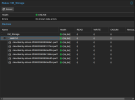I need some help here. This is my first encounter with Proxmox. I made the switch after ESXi's free version went away.
Here's my hardware:
Dell Poweredge R710
128GB of RAM,
24 x Intel(R) Xeon(R) CPU X5670 @ 2.93GHz (2 Sockets),
6x 6TB 12Gb/s SAS drives connected to an HBA configured as a ZFS for VM images
1x 256GB SSD for the OS
An NFS connection to my other server running UNRAID that stores ISOs and some data backups
I've scoured the forums and tried various suggestions in different threads to try to get some better performance out of my ZFS array and it's just not happening for me. I've enabled thin provisioning, turned on discard, enabled SSD emulation, dialed back the memory allocated to ZFS, and my VMs still run so slow I feel like I need to get out and push.
Additionally, my VMs in the GUI are reporting that they're using almost every bit of RAM allocated to them, though htop doesn't seem to agree.
I need some help to troubleshoot this. I never had any problem running 8 simultaneous VMs under ESXi so I doubt very much that I have a hardware problem to speak of, just a configuration issue and most probably not wholly understanding the ins-and-outs of Proxmox well enough to properly tailor my configuration.
If someone could help me troubleshoot this, I would be greatly appreciative. You can speak Linux to me, I'm well versed, but ZFS is a new concept for me and I suspect I may just not have it set up correctly. For all the fanfare that ZFS got over HW RAID in terms of efficiency and flexibility, I have yet to have that experience.
Here's my hardware:
Dell Poweredge R710
128GB of RAM,
24 x Intel(R) Xeon(R) CPU X5670 @ 2.93GHz (2 Sockets),
6x 6TB 12Gb/s SAS drives connected to an HBA configured as a ZFS for VM images
1x 256GB SSD for the OS
An NFS connection to my other server running UNRAID that stores ISOs and some data backups
I've scoured the forums and tried various suggestions in different threads to try to get some better performance out of my ZFS array and it's just not happening for me. I've enabled thin provisioning, turned on discard, enabled SSD emulation, dialed back the memory allocated to ZFS, and my VMs still run so slow I feel like I need to get out and push.
Additionally, my VMs in the GUI are reporting that they're using almost every bit of RAM allocated to them, though htop doesn't seem to agree.
I need some help to troubleshoot this. I never had any problem running 8 simultaneous VMs under ESXi so I doubt very much that I have a hardware problem to speak of, just a configuration issue and most probably not wholly understanding the ins-and-outs of Proxmox well enough to properly tailor my configuration.
If someone could help me troubleshoot this, I would be greatly appreciative. You can speak Linux to me, I'm well versed, but ZFS is a new concept for me and I suspect I may just not have it set up correctly. For all the fanfare that ZFS got over HW RAID in terms of efficiency and flexibility, I have yet to have that experience.


